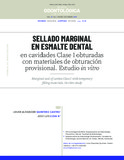Mostrar el registro sencillo del ítem
Sellado marginal en esmalte dental en cavidades Clase I obturadas con materiales de obturación provisional. Estudio in vitro
| dc.rights.license | http://creativecommons.org/licenses/by-nc-sa/3.0/ve/ | es_VE |
| dc.contributor.author | Quintero Castro, Leiver Alexander | |
| dc.date.accessioned | 2019-06-17T16:06:51Z | |
| dc.date.available | 2019-06-17T16:06:51Z | |
| dc.date.issued | 2019 | |
| dc.identifier.issn | 1856-3201 | |
| dc.identifier.uri | http://www.saber.ula.ve/handle/123456789/45837 | |
| dc.description.abstract | Las obturaciones provisionales protegen el remanente dental coronario por un periodo de tiempo corto (entre una cita y otra), mientras se obtura definitivamente. La microfiltración es el paso de bacterias, fluidos, moléculas y/o iones entre la pared cavitaria y el material restaurador colocado en ella, lo que puede provocar sensibilidad postoperatoria, riesgo en el desarrollo de caries recidivante y patologías pulpares. El propósito de esta investigación fue evaluar la microfiltración marginal en cavidades clase I obturadas con tres materiales de obturación provisional que se trataron con una tinción de nitrato de azul de metileno 0.50 g/ml y sometidas al proceso de termociclado. La prueba de la mediana x 2 p= .0062 implica diferencias significativas entre los materiales utilizados. x 2 p= 0006 para la microfiltración en los túbulos dentinarios implica diferencias significativas entre los métodos 1 (Cinquenol de DPI Dental®) método 2 (Coltosol F de Coltene AG ®) y método 3 (Clip F de Voco®). El resultado obtenido con la prueba H de Kruskal-Wallis p=0.0049 < 0.05, infiere que el método 2 (Coltosol F) es significativo para la menor penetración del tinte en la interfaz, siguiéndole el método 3 (Clip F y de último el método 1 (Cinquenol). Al verificar la prueba H de Kruskal-Wallis < 0.05, infiere que hay suficiente evidencia estadística para sostener que el valor H> 8.00, implica que los métodos 2 y 3, son los que tiene menor penetración del tinte a nivel de los túbulos dentinarios, siguiéndole el método 1. | es_VE |
| dc.language | es | |
| dc.language.iso | es | es_VE |
| dc.publisher | SaberULA | es_VE |
| dc.rights | info:eu-repo/semantics/openAccess | es_VE |
| dc.subject | Filtración dental | es_VE |
| dc.subject | Restauración dental provisional | es_VE |
| dc.title | Sellado marginal en esmalte dental en cavidades Clase I obturadas con materiales de obturación provisional. Estudio in vitro | es_VE |
| dc.title.alternative | Marginal seal of cavites Class I with temporary filling materials. In vitro study | es_VE |
| dc.type | info:eu-repo/semantics/article | es_VE |
| dcterms.dateAccepted | 19/11/2018 | |
| dcterms.dateSubmitted | 26/03/2018 | |
| dc.description.abstract1 | Provisional fillings protect the coronary tooth remnant for a short period of time (between one appointment and another), while permanently sealing. Microfiltration is the passage of bacteria, fluids and molecules between the cavity wall and the restorative of the material placed in it, which could cause post-operative sensitivity, risk in the development of recurrent caries and pulpal pathologies. The objective of this investigation was to evaluate the marginal microfiltration in class I cavities filled with three provisional obturation materials that were submitted to methylene blue nitrate stain 0.45 gr / ml and some to the thermocycling process. The test of the median x 2 p = .0062 implies significant differences between the materials used. x 2 = 0006 for microfiltration in dentinal tubules implies significant differences between methods 1 (Cinquenol) method 2 (Coltosol F) and 3 (Clip F). The result obtained with the Kruskal-Wallis H test p = 0.0049 <0.05 infers that Method 2 (Coltosol F) is significant for the lower penetration of the dye in the interface, following Method 3 (Clip F) and last Method 1 (Cinquenol). When verifying the Kruskal-Wallis H test <0.05, it infers that there is sufficient statistical evidence to support that the H value> 8.00, implies that methods 2 and 3, are those that have lower penetration of the dye at the level of the dentinal tubules, following the method 1. | es_VE |
| dc.description.colacion | 12-23 | es_VE |
| dc.description.email | leiver10@hotmail.com | es_VE |
| dc.description.frecuencia | Semestral | |
| dc.identifier.depositolegal | PP200502ME2052 | |
| dc.identifier.edepositolegal | PPI 201202ME4105 | |
| dc.identifier.eissn | 2244-8861 | |
| dc.publisher.pais | Venezuela | es_VE |
| dc.subject.facultad | Facultad de Odontología | es_VE |
| dc.subject.institucion | Universidad de Los Andes (ULA) | es_VE |
| dc.subject.keywords | Dental Leakage | es_VE |
| dc.subject.keywords | Dental Restoration, Temporary | es_VE |
| dc.subject.publicacionelectronica | Revista Odontológica de Los Andes | |
| dc.subject.seccion | Revista Odontológica de Los Andes: Trabajos de investigación | es_VE |
| dc.subject.thematiccategory | Medicina y Salud | es_VE |
| dc.subject.tipo | Revistas | es_VE |
| dc.type.media | Texto | es_VE |
Ficheros en el ítem
Este ítem aparece en la(s) siguiente(s) colección(ones)
-
Revista Odontológica de Los Andes - Vol. 014 - Nº 1
Enero - Junio 2019


